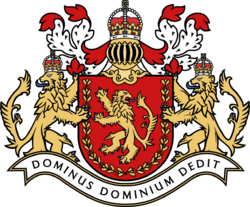Muster Service (Great Nortend)
| Muster Service | |
|---|---|
 | |
| Active | 8 June 1936 — |
| Country | |
| Role | National service |
| Insignia | |
| War Cross | |
| Red Ensign | |
| Blue Ensign | |
Muster Service is the name given for the system of universal male peace-time conscription practised in Great Nortend. Certain male subjects are required to muster and serve upon attaining the age of eighteen, subject to exemptions. Women, being mostly excluded from the armed forces, are not subject to Muster Service.
History
A form of communal conscription has been practised in Great Nortend since at least the mediaeval period. Each manor was required to send one or more trained knights to fight in the King's armies as required. This system of servitium militare persisted in modified form over the centuries, operating on a part-standing basis. However, it was increasingly felt that this feudal system of part-time military service was inadequate to protect the newly regained Isles of Hastica from the Exponential Empire in 1743. A professional standing army was thus raised with the promulgation of the Defence of the Realm Act, 11 Maria I., p. 1. The existing system of quasi-feudal service was completely reformed and incorporated into the civilian militia and yeomanry.
By the Defence of the Realm Act 34 Edm. IX, these militas and yeomanries were consolidated into the Home Service. However, there was still no general conscription of civilians until the Defence of the Realm Act 46 Edm. IX p. 45 when it was declared that certain able were were to be “mustered” to serve as men at arms. The introduction of universal conscription was promoted by the Lord Treasurer, Sir Henry de Foide, and the War Clerk, Clerenbold Thatcher, as the necessary response to concerns of declining standards and increased inefficiency and conflict in the Home Service after the last of the Great Astyrian War veterans were paid out of the service.
Muster Service was a great shift in Erbonian society's relationship with the armed forces, which had been mostly the preserve of a select few within a community. The continual perceived threat of the international Red Communists likely played a part in public acceptance of this new peace-time conscription programme, although it was generally in line with Foide's National Conservative Party focus on nationalism and demonstrations of allegiance to the Crown.
Requirements
The Muster Service programme requires all boys at the age of seventeen to register with the War Office and declare their eligiblity. There are exemptions to compulsory muster, although voluntary muster is still possible. These are :—
- Boys entering a privileged occupation
- Clerks in holy orders
- Peers and their heirs
Several conditions render a person ineligible for muster. These are :—
- Physical unfitness
- Convicted felon status
- Inability to take oaths
Of the 45 per cent of potentially eligible subjects who are declared exempt, most are boys entering a privileged occupation. This includes most forms of agricultural husbandry, coal mining and fishing. The majority of the rest are ineligible owing to inability to take oaths or physical unfitness.
Service
At the age of eighteen, after the end of any senior schooling, approved young men receive their letters of muster, ordering them to muster to begin their year of muster service. There are four intake periods annually. As a general rule, mustermen from a single village or district are sent to different units.
Muster servicemen undergo two months of initial military training at a Muster Training College (M.T.C.) and two months of specialised corps training at a Corps Training College (C.T.C.), followed by eight months of service posted somewhere in Great Nortend or abroad. This eight months of service includes periods of both military service as well as forms of labour service. After this total one year period of muster, ordinary mustermen are discharged from full-time service. Thereafter, they may choose to join the Home Service to serve part-time in the local defence force for another eight years. Alternatively, they may leave by paying a fine known as scutage, which amounts to the annual salary of a full-time soldier.
Officers are not mustered. Instead, those eligible join the Staff Cadet Corps training part time for three years. In their first and last years, they attend the Royal Military College or Royal Naval College for short courses, followed by commissioning as an Ensign, Cornet, Midshipman or Pilot as appropriate. Thereafter, they undertake one year of full-time service, usually in charge of a muster platoon. Despite this longer commitment, most men eligible to serve as officers choose to do so, owing to the higher pay, conditions and prestige.
This page is written in Erbonian English, which has its own spelling conventions (colour, travelled, centre, realise, instal, sobre, shew, artefact), and some terms that are used in it may be different or absent from other varieties of English. |



